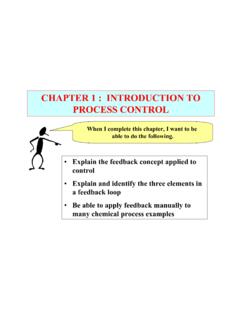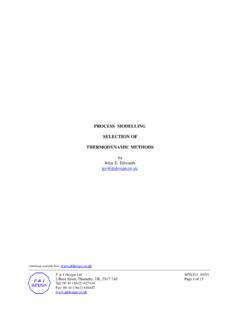Transcription of Solutions for Tutorial 3 Modelling of Dynamic Systems
1 McMaster University 11/05/05 Copyright 2000 by T. Marlin 1 Solutions for Tutorial 3 Modelling of Dynamic Systems Mixer: Dynamic model of a CSTR is derived in textbook Example From the model, we know that the outlet concentration of A, CA, can be affected by manipulating the feed concentration, CA0, because there is a causal relationship between these variables. a. The feed concentration, CA0, results from mixing a stream of pure A with solvent, as shown in the diagram.
2 The desired value of CA0 can be achieved by adding a right amount of A in the solvent stream. Determine the model that relates the flow rate of reactant A, FA, and the feed concentration, CA0, at constant solvent flow rate. b. Relate the gain and time constant(s) to parameters in the process . c. Describe a control valve that could be used to affect the flow of component A. Describe the a) valve body and b) method for changing its percent opening (actuator).
3 Figure a. In this question, we are interested in the behavior at the mixing point, which is identified by the red circle in the figure above. We will apply the standard Modelling approach to this question. Goal: Determine the behavior of CA0(t) System: The liquid in the mixing point. (We assume that the mixing occurs essentially immediately at the point.) SolventReactantFoCAOF1 CAFsCA,solventFACA,reactantMcMaster University 11/05/05 Copyright 2000 by T.
4 Marlin 2 Balance: Since we seek the behavior of a composition, we begin with a component balance. Accumulation = in - out + generation (1) ()()0)CFF(CFCFtMX|CV|CVMW0 AASAAAASSAt0 Amtt0 AmA++ + = + Note that no reaction occurs at the mixing point. We cancel the molecular weight, divide by the delta time, and take the limit to yield (2) 0 AAAASAASASSAASmCCFFFCFFFdtdC)FF(V +++=+ No reactant (A) appears in the solvent, and the volume of the mixing point is very small.
5 Therefore, the model simplifies to the following algebraic form. (3) 0 AAAASACCFFF=+ Are we done? We can check degrees of freedom. DOF = 1 1 = 0 Therefore, the model is complete. CA0 (FS, FA, and CAA are known) You developed models similar to equation (3) in your first course in Chemical Engineering, Material and Energy balances. (See Felder and Rousseau for a refresher.) We see that the Dynamic Modelling method yields a steady-state model when the time derivative is zero.
6 Note that if the flow of solvent is much larger than the flow of reactant, FS >> FA, then, (4) ASAA0AF FCC = If FS and CAA (concentration of pure reactant) are constant, the concentration of the mixed stream is linearly dependent on the flow of reactant. b. For the result in equation (4), Time constant = 0 (This is a steady-state process .) Gain = CAA/FS (The value will change as FS is changed.) McMaster University 11/05/05 Copyright 2000 by T. Marlin 3 c. The control valve should have the following capabilities.
7 1. Introduce a restriction to flow. 2. Allow the restriction to be changed. 3. Have a method for automatic adjustment of the restriction, not requiring intervention by a human. 1&2 These are typically achieved by placing an adjustable element near a restriction through which the fluid must flow. As the element s position in changed, the area through which the fluid flows can be increased or decreased. 3 This requirement is typically achieved by connecting the adjustable element to a metal rod (stem).
8 The position of the rod can be changed to achieve the required restriction. The power source for moving the rod is usually air pressure, because it is safe (no sparks) and reliable. A rough schematic of an automatic control valve is given in the following figure. See a Valve You can see a picture of a typical control valve by clicking here. Many other valves are used, but this picture shows you the key features of a real, industrial control valve. Hint: To return to this current page after seeing the valve, click on the previous view arrow on the Adobe toolbar.
9 You can read more about valves at the McMaster WEB site. air pressurevalve stem positiondiaphramspringvalve plug and seatMcMaster University 11/05/05 Copyright 2000 by T. Marlin 4 Stirred tank mixer a. Determine the Dynamic response of the tank temperature, T, to a step change in the inlet temperature, T0, for the continuous stirred tank shown in the Figure below. b. Sketch the Dynamic behavior of T(t). c. Relate the gain and time constants to the process parameters.
10 D. Select a temperature sensor that gives accuracy better than 1 K at a temperature of 200 K. Figure We note that this question is a simpler version of the stirred tank heat exchanger in textbook Example Perhaps, this simple example will help us in understanding the heat exchanger example, which has no new principles, but more complex algebraic manipulations. Remember, we use heat exchangers often, so we need to understand their Dynamic behavior.

